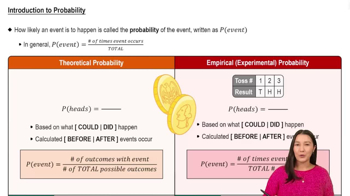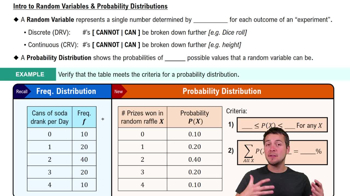How many ways are there to arrange the letters in the word CALCULUS?
Table of contents
- 1. Intro to Stats and Collecting Data1h 14m
- 2. Describing Data with Tables and Graphs1h 55m
- 3. Describing Data Numerically2h 5m
- 4. Probability2h 16m
- 5. Binomial Distribution & Discrete Random Variables3h 6m
- 6. Normal Distribution and Continuous Random Variables2h 11m
- 7. Sampling Distributions & Confidence Intervals: Mean3h 23m
- Sampling Distribution of the Sample Mean and Central Limit Theorem19m
- Distribution of Sample Mean - Excel23m
- Introduction to Confidence Intervals15m
- Confidence Intervals for Population Mean1h 18m
- Determining the Minimum Sample Size Required12m
- Finding Probabilities and T Critical Values - Excel28m
- Confidence Intervals for Population Means - Excel25m
- 8. Sampling Distributions & Confidence Intervals: Proportion1h 12m
- 9. Hypothesis Testing for One Sample3h 29m
- 10. Hypothesis Testing for Two Samples4h 50m
- Two Proportions1h 13m
- Two Proportions Hypothesis Test - Excel28m
- Two Means - Unknown, Unequal Variance1h 3m
- Two Means - Unknown Variances Hypothesis Test - Excel12m
- Two Means - Unknown, Equal Variance15m
- Two Means - Unknown, Equal Variances Hypothesis Test - Excel9m
- Two Means - Known Variance12m
- Two Means - Sigma Known Hypothesis Test - Excel21m
- Two Means - Matched Pairs (Dependent Samples)42m
- Matched Pairs Hypothesis Test - Excel12m
- 11. Correlation1h 6m
- 12. Regression1h 50m
- 13. Chi-Square Tests & Goodness of Fit1h 57m
- 14. ANOVA1h 57m
4. Probability
Counting
Problem 4.4.6
Textbook Question
Social Security Numbers A Social Security number consists of nine digits in a particular order, and repetition of digits is allowed. After seeing the last four digits printed on a receipt, if you randomly select the other digits, what is the probability of getting the correct Social Security number of the person who was given the receipt?
 Verified step by step guidance
Verified step by step guidance1
Step 1: Understand the structure of a Social Security number. It consists of nine digits, and repetition of digits is allowed. Each digit can range from 0 to 9, giving 10 possible choices for each digit.
Step 2: Recognize that the last four digits are already known from the receipt. Therefore, you only need to randomly select the remaining five digits to match the correct Social Security number.
Step 3: Calculate the total number of possible combinations for the five unknown digits. Since each digit has 10 possible values and repetition is allowed, the total number of combinations is given by \( 10^5 \), which represents 10 choices for each of the 5 digits.
Step 4: Realize that there is only one correct combination of the five unknown digits that matches the Social Security number of the person who was given the receipt.
Step 5: Compute the probability of selecting the correct combination. The probability is the ratio of the number of favorable outcomes (1 correct combination) to the total number of possible outcomes (\( 10^5 \)). This can be expressed as \( P = \frac{1}{10^5} \).
 Verified video answer for a similar problem:
Verified video answer for a similar problem:This video solution was recommended by our tutors as helpful for the problem above
Video duration:
3mPlay a video:
Was this helpful?
Key Concepts
Here are the essential concepts you must grasp in order to answer the question correctly.
Probability
Probability is a measure of the likelihood that a particular event will occur, expressed as a number between 0 and 1. In this context, it refers to the chance of randomly selecting the correct Social Security number from all possible combinations. Understanding how to calculate probability is essential for determining the likelihood of achieving a specific outcome.
Recommended video:

Introduction to Probability
Combinatorics
Combinatorics is a branch of mathematics dealing with counting, arrangement, and combination of objects. In the case of Social Security numbers, it helps in calculating the total number of possible combinations of digits. Since there are nine digits with repetition allowed, combinatorial principles are crucial for understanding the total outcomes when selecting the digits.
Random Selection
Random selection refers to the process of choosing items from a set in such a way that each item has an equal chance of being chosen. In this scenario, it involves selecting the first five digits of a Social Security number randomly after knowing the last four. This concept is important for understanding how the selection process affects the probability of obtaining the correct number.
Recommended video:
Guided course

Intro to Random Variables & Probability Distributions

 7:11m
7:11mWatch next
Master Introduction to Permutations with a bite sized video explanation from Patrick
Start learningRelated Videos
Related Practice
Multiple Choice
